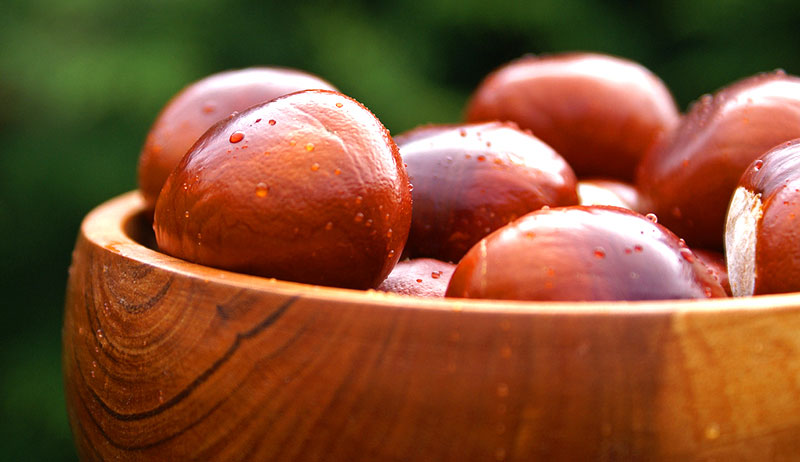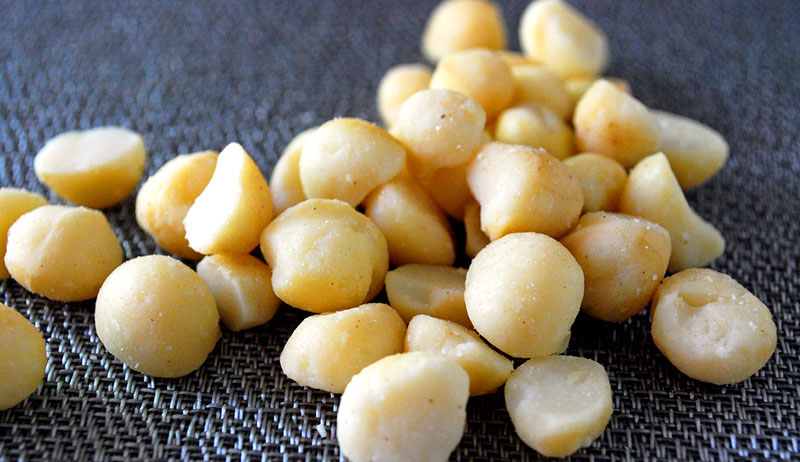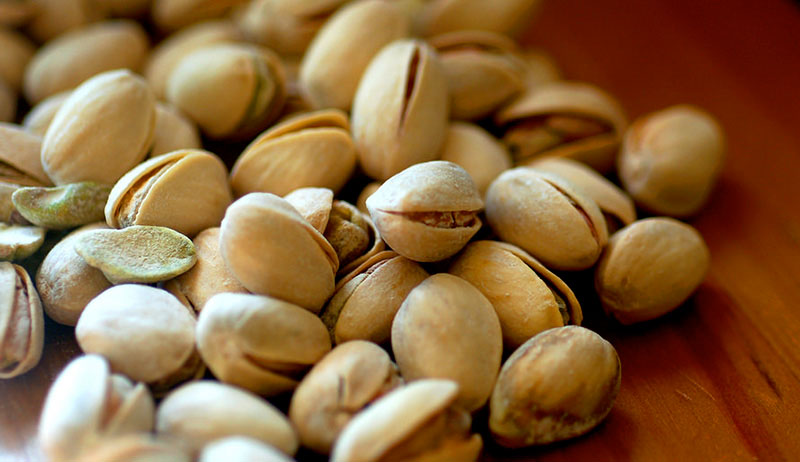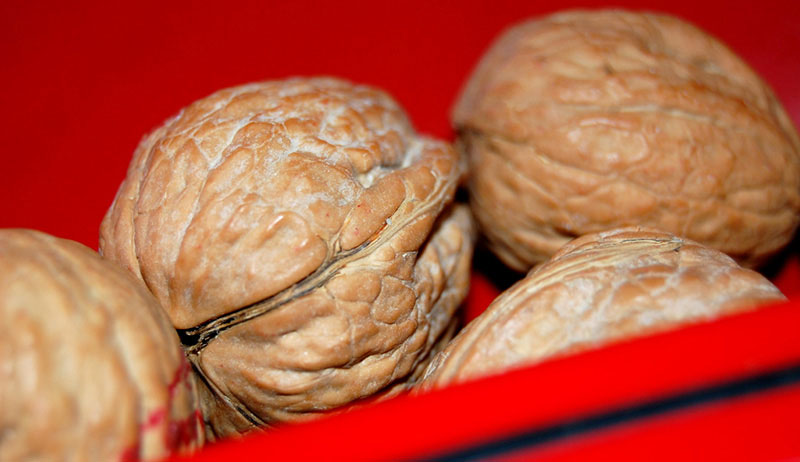
Timber trees put their energy into growing up to the canopy. Orchard trees, on the other hand, selected to be short and spreading, put their energy into the production of nuts. Here’s a sampling of nut varieties and their characteristics to help you choose the right nut trees to grow on your farm.
1. Almond (Prunus amygdalus)

The almond is related to apples, pears and peaches—the fuzzy almond hull even looks like an unripe peach. Extremely early blooming makes almonds susceptible to killing frosts. They do best in a hot, dry climate, such as California’s Great Central Valley. Almond trees produce nuts in about five years and can reach about 25 feet tall. They must have two cultivars for cross-pollination and are pollinated by Honey bees.
2. Chestnut (Castanea sp.)

Before chestnut blight nearly wiped out the North American chestnut (C. dentata), it comprised a quarter of all trees in the Carolinian forests of North America—through the Appalachian Mountains and into Canada.
Today, plant scientists are attempting to bring chestnut trees back from the brink, backcrossing the North American species and blight-resistant Asian species, such as Chinese and Japanese chestnuts (C. mollissima and C. crenata, respectively)—both of which also grow in the U.S. Depending on which of the thousands of cultivars are planted, chestnuts will grow in regions as far north as Michigan, Wisconsin and Canada and as far south as Georgia and northern Florida.
Depending on the variety, chestnuts grow 40 to 80 feet wide and high, though the size of this new variety under development isn’t yet known.
“Chestnuts are very easy to grow,” says Sandra Anagnostakis, PhD, a chestnut scientist at the Connecticut Agricultural Experiment Station “A chestnut orchard will require less investment in spraying for pests than, say, apples or peaches.”
The real limitation is soil type and adequate moisture.
“They can be grown in places with acid soil, [but] in places, such as California, where the soil is neutral, only a few cultivars will do well,” she says. “If you’re foolish enough to buy a seedling tree, you’ll wait for 10 years for them to start flowering and fruiting. If you buy grafted trees, they’ll start fruiting the second year,” says Anagnostakis. “Since they’re all self-sterile, you have to plant two different cultivars—both of which will produce pollen for cross-pollination. You’ll also have two different kinds of nuts and maybe two different harvest times.”
Bill Reid, PhD, nut tree crops specialist at Kansas State University, sees two disadvantages to chestnuts, which he laughingly calls “the potato of the nut world.” One is the unpleasant scent of chestnut flowers and the other is disposing of the prickly burr or husk. The chestnuts fall when the husks mature and split naturally, still on the trees. The empty husks will fall to the ground later. The shells or skins of the nuts can be peeled off with a knife or even bitten through with your teeth, if you’re eating them raw.
Edible chestnuts are not related to horse chestnuts.
3. Hazelnut (Corylus sp.)

The hazelnut, or filbert, performs best in moderate climates, but hazels need 800 to 1,200 chill hours to flower and break dormancy. Too far south, they may flower too early or out of sequence with pollination. Although hazels bear both male and female flowers, they are not self-pollinating and need at least two different cultivars because some cultivars won’t pollinate each other. Growers should plant four to six different cultivars to get consistent crops.
In America, eastern filbert blight fungus has limited commercial hazelnut orchards to Oregon’s Willamette Valley, but the development of blight-resistant and cold-hardy hybrids may enable the hazelnut to become a sustainable crop for much of the United States and southern Canada. The plant can be a 3-foot shrub or a 30-foot tree, depending on rootstock and pruning. Grafted or layered hazels will start producing within two to three years and can stay productive for 60 years.
Disease-resistant and cold-hardy hazelnuts have the potential to become a valuable part of the sustainable-agriculture movement, according to Tom Molnar, PhD, hazelnut expert at Rutgers University.
“We’re right on the edge,” he says. The trees are very low input, “something that you could take care of on weekends.”
Hazelnuts require only a few (if any) sprays for bud mites or blights, compared to grapes, peaches or apples, and need much less pruning. Most hazels grow naturally as large multistemmed shrubs. Even with a bush, you’ll still be able to harvest a crop, says Molnar. But if suckers around the base are pruned two or three times per year to leave a single tree trunk, all the energy goes into the mature wood, which equals more flowering and sooner bearing. Single-trunked trees are also easier to maintain for weed control, mowing the orchard and harvesting.
“They’ll do really well on soils that are moderately acidic, and they respond very well to nitrogen fertilizer,” Molnar says. Weed control will keep trees healthy, but his test trees haven’t needed pest control.
Hazelnuts are drought-tolerant and will grow where other crops won’t, such as on slopes and in marginal soils.
Molnar admits that planting more than 1 acre or so may not be a wise investment, as yield consistency is one of the things being tested in Rutgers University trials.
“But there’s a lot of potential,” he says. “For the hobby or backyard gardener—for your own consumption or growing for a local farm market—I think it’s a great plant!”
4. Hickory (Carya sp.)

The shagbark hickory (C. ovata) and shellbark (C. laciniosa) hickory are eastern North America natives, ranging from southern Canada to northern Mexico. They are slow-growing trees that may take decades to bear nuts but can live for centuries. Grafted hickory varieties may yield more reliable but not faster nut production. Hickory trees need a very long taproot before they can begin producing nuts.
Hickories are very cold-hardy, adapt well to disturbed areas and tolerate poor soils. They produce small, sweet nuts within extremely sturdy shells. The trees grow to about 60 feet tall. You have to plant two varieties whose flowering and pollen-shedding suit each other’s pollination timing.
5. Macadamia (Macadamia integrifolia)

The macadamia, introduced to Hawaii from Australia in the late 19th century, can also grow and produce well in small regions of southwestern California and southern Florida.
6. Pecan (Carya illinoensis)

The pecan is another member of the hickory family. An extremely slow-growing species, it takes years to establish the massive root system it needs before it can begin to grow wood and may take five to 10 years to bear nuts. The trees can live 130 years or more and grow 90 feet tall and 120 feet wide—really! Pecan trees can be cultivated and grow well outside their natural range, which is from Texas through Kansas, Missouri and Illinois, but need a lot of summer day- and night-time heat. They are self-pollinating, though nuts from cross-pollinated trees may be of higher quality.
For Reid, “Pecans are king!” Husk removal and disposal are not a problem with pecans, which he believes are unmatched in taste.
For farms on the northern edge of the pecan zone in Oklahoma, Missouri, Kansas and Illinois, he recommends Kanza, a cultivar that he helped release in the mid-1980s. It’s scab-resistant, ripens early in a large area of the country, and produces an excellent medium-sized nut that fills the kernel no matter what the rainfall pattern.
“Once they get up to size, you don’t do annual pruning,” he says. Maintenance pruning is to “keep them from hitting you in the head when you’re mowing underneath.”
“Planting a pecan tree is an act of faith,” he says. Even with grafted trees, pecans are among the slowest crops to establish. Until they grow a massive root system, the top of the tree won’t grow, Reid explains: “It’s only by about year 13 that you’ll get ‘Oh my goodness! I’ll have to start doing something with all these nuts!’
“I’m shaking trees for nut production that are nearly 4 feet in diameter,” he says. As trees get larger, they sometimes have to be thinned to give the remaining trees room to grow; “If they shade each other, nut production moves to the very top of the tree.” The trees must be fertilized annually and sprayed for insects and for disease, if they’re susceptible.
Unlike walnuts and hickories, the husks, or shucks, split and dry on their own once the first freeze hits them. “Commercially, we let them dry on the trees,” says Reid. “Once we put the shaker on the tree, the nuts just come out—that’s the beauty of pecans!”
The hican is a naturally occurring hickory-pecan hybrid that tastes like a combination of the two and has a more-easily cracked shell than hickories. Hican trees can grow to 60 feet and may take six to 10 years to produce a crop.
7. Pine Nut (Pinus edulis)

Evergreen piñons or pinions, native to western states, produce kernels in their pinecones. Depending on the species and growing conditions, pine nut trees may be large or small, fast- or slow-growing, heat-tolerant or cold-hardy, and produce only a few or up to 200 kernels per cone.
8. Pistachio (Pistacia sp.)

The slow-growing pistachio thrives in regions with short, cold winters followed by hot, dry summers. Drought-tolerant, the tree grows well in arid sandy-soiled regions of the American Southwest with plenty of sun, where there are no frosts to kill its spring blooms.
9. Walnut (Juglans sp.)

Walnuts include the eastern North America native black walnut (J. nigra), the butternut (J. cinerea), the heartnut (J. sieboldiana), and what is regionally referred to as the Persian, English or Carpathian walnut (J. regia). Walnuts do well with full sun and deep, well-drained loamy soil and require 400 to 1,500 hours of cold weather, depending on the cultivar. They must be cross-pollinated. They can take three to five years to produce a crop and can live for centuries. The trees grow 50 to 100 feet tall and wide, depending on the variety. Because walnut trees’ roots excrete a substance that inhibits the growth of many other plants, keep them well away from vegetable and flower gardens. Unlike other nut trees, walnuts should be pruned in the fall. At harvest, wear gloves—the husks are tenacious and leave indelible stains.
The newer walnut-blight-resistant cultivars produce nuts that are five times bigger than the native North American variety. According to Anagnostakis, “You can usually put about 30 trees on an acre, and at about 100 pounds per tree, that’s a lot!”




